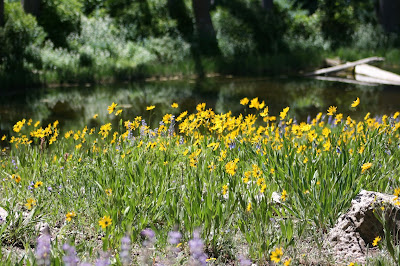Walking with Wildflowers
This past summer I worked as an interpretation ranger intern at Cedar Breaks National Monument*. It was an inspiring adventure to work outdoors and introduce people to the monument. It is famous for it's natural amphitheater, which is home to a maze of rock structures called hoodoos. The amphitheater is over half a mile deep and is so steep that it is inaccessible from above.
 |
| Here is a picture from the main view point of the park. You can see a portion of the amphitheater to the right. |
Even though most visitors come to Cedar Breaks for the view (or by accident, we're a rather small park) those who visit in late June through mid-July are in for a pleasant surprise.
It's wildflower season!! Because Cedar Breaks is located at 10,000+ feet of elevation, the actual "breaks" or amphitheater is surrounded by a beautiful subalpine forest. This protected forested area combined with the precipitation makes for the perfect storm of wildflowers.
Every week seems to change which flower is most dominant, and there are even some flowers that are only found within the park. During the peak of this color show, I had lots of family visit to see the stunning array.
One visit was from my mom and grandma Jojo.
 |
| My mom and Jojo standing in a field of Little Sunflowers on the Alpine Pond hike. |
It was such a fun trip to show these two everything I do and all the beautiful flowers; we plan to make it a yearly event! The Alpine Pond hike is my favorite hike during wildflower season, and it didn't disappoint when these two came to stay with me. Here are some more pictures of the weekend.
...
And just a few more close up of some flowers :)
 |
| Subalpine Larkspur (photo credit to my dad for catching this sweet bee) |
 |
| Death Camas. Appropriately named, every part of Death Camas, from its bulb to its petals, is extremely poisonous. |
 |
| Elephants Head. A small flower that grows in marshy areas. |
 |
| Monkshood. Also a poisonous plant, it was historically used to poison water sources and tip arrow heads in medieval Europe and Asia. |
 |
| A group of Monkshood growing near the park boundary. |
These next few pictures show the Alpine Pond Trail. The yellow flowers you see are Little Sunflowers. They look just like their namesake, but only grow a few feet high.












Comments
Post a Comment